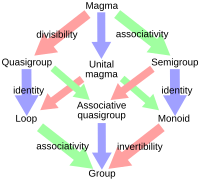Loop (algebra)

Imagine you have a piece of string that you can stretch out in a straight line, just like on a number line. Now, you can tie the two ends of the string together to make a loop. This loop is like a closed circuit, where you can travel around it and end up where you began.
In algebra, a loop is sort of like that string loop. Instead of a physical string, we use a set of mathematical objects, like numbers or matrices. We can perform operations on these objects, just like we can move around the loop.
When we start at a point in the loop and perform an operation, we end up at another point on the loop. If we keep performing different operations, we keep moving around the loop in a cycle. We call this cycle the loop's structure.
Different loops can have different structures, just like different strings can make different shaped loops. The structure of a loop helps us understand how its operations work together.
For example, let's consider a loop made up of the numbers 0, 1, 2, and 3. We can perform an operation called addition, where we add two numbers and take the remainder when we divide by 4. For example, 1 + 3 = 0 (because 1 + 3 = 4, which leaves a remainder of 0 when divided by 4).
Using this addition operation, we can start at any number in the loop and move around. If we start at 0 and add 1, we get 1. If we add 1 again, we get 2. If we add 1 again, we get 3. And if we add 1 one more time, we get back to 0! This means that the loop has a structure of 4, since it takes 4 operations to get back to where we started.
In summary, a loop in algebra is like a closed circuit made up of mathematical objects that we can manipulate with operations. The loop's structure tells us how these operations work together to create a cycle.
In algebra, a loop is sort of like that string loop. Instead of a physical string, we use a set of mathematical objects, like numbers or matrices. We can perform operations on these objects, just like we can move around the loop.
When we start at a point in the loop and perform an operation, we end up at another point on the loop. If we keep performing different operations, we keep moving around the loop in a cycle. We call this cycle the loop's structure.
Different loops can have different structures, just like different strings can make different shaped loops. The structure of a loop helps us understand how its operations work together.
For example, let's consider a loop made up of the numbers 0, 1, 2, and 3. We can perform an operation called addition, where we add two numbers and take the remainder when we divide by 4. For example, 1 + 3 = 0 (because 1 + 3 = 4, which leaves a remainder of 0 when divided by 4).
Using this addition operation, we can start at any number in the loop and move around. If we start at 0 and add 1, we get 1. If we add 1 again, we get 2. If we add 1 again, we get 3. And if we add 1 one more time, we get back to 0! This means that the loop has a structure of 4, since it takes 4 operations to get back to where we started.
In summary, a loop in algebra is like a closed circuit made up of mathematical objects that we can manipulate with operations. The loop's structure tells us how these operations work together to create a cycle.
Related topics others have asked about:
